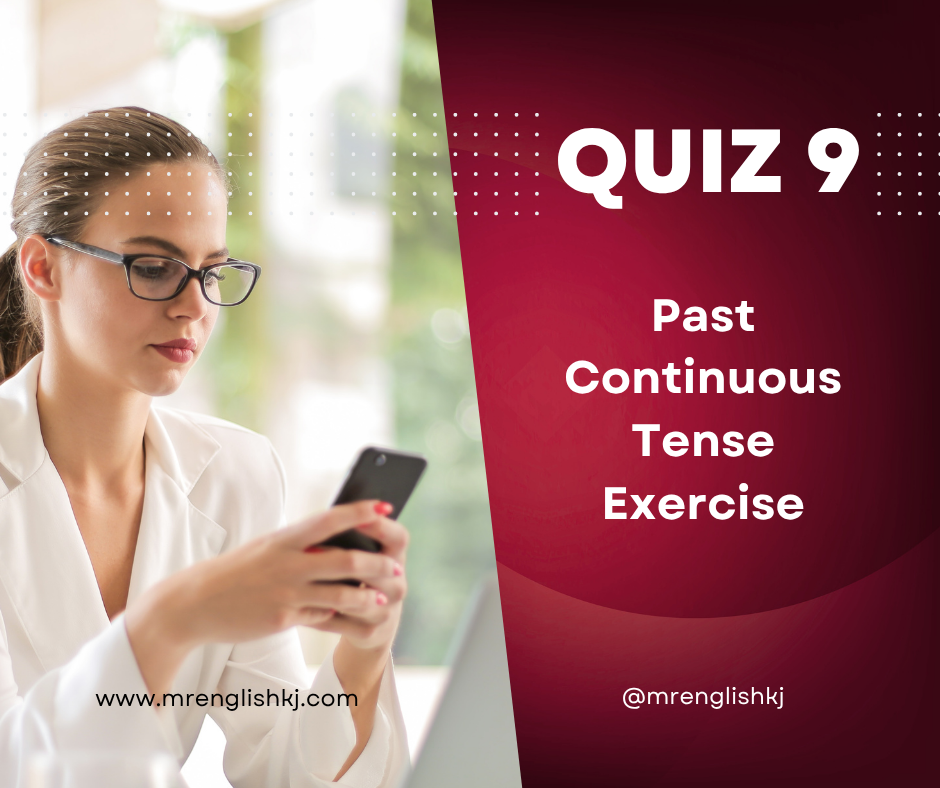
Past Continuous Tense — Exercise 9 (Q&A with Full Explanation and Vocabulary Builder, Learn English)
This practice test trains you to recognize and use the Past Continuous Tense (was/were + verb-ing) in real contexts. Each question includes the correct past-continuous form, a short verb definition (vocabulary builder + POS notes), and detailed one-sentence explanations for every option (A–D) that tell why the option is correct or incorrect and what choosing it would mean. Practice, prepare and improve both English grammar and vocabulary.
English Grammar Definition: Past Continuous (was/were + verb-ing)
- Form: was / were + present participle (-ing).
- Examples: I was writing; They were waiting; Was she sleeping?
- Main uses:
- Ongoing actions in the past (background actions).
- Actions that were in progress when another action interrupted.
- Parallel past actions (two things happening at the same time).
- Signal words: while, as, at 10 a.m., when, during.
- Negatives / Questions: was/were not (wasn’t/weren’t) + verb-ing; Was/Were + subject + verb-ing?
- To learn more about it – Visit Here
Quiz Instructions
- Read each question and choose the best answer out of four given options.
- On top, header section of the quiz, you will see the “title of the quiz,’ ‘spending-time,’ ‘value of question in points,’ and ‘number of questions.”
- Below on footer, you will see Full Screen mode. As the name suggests, it covers the whole screen. It will save a lot of your time attempting the quiz.
- You can zoom the images given in the questions.
- After submitting the quiz, you can see your score and compare with other users.
- The Full Leaderboard link will take you to a page, where you can see all users attempts.
- Below the quiz box, there are explanation of each options. You can study and try again.
- Best of Luck!
Quiz Question, Answer and Explanation
Note: Do remember in the quiz box above, the questions and options will shuffle, so they won’t have the same sequence like 1, 2, 3, or A, B, C as below.
1. The buffer manager __ frames to the GPU while the renderer queued tasks.
A) was buffering B) buffered C) is buffering D) has buffered
Verb: buffer — verb. To temporarily store data while processing.
Correct: A) was buffering
A) Correct: Past continuous — buffering was ongoing during rendering; choosing it shows temporary storage in progress.
B) Wrong: Past simple — indicates a completed buffer action.
C) Wrong: Present — wrong timeframe.
D) Wrong: Present perfect — implies present state.
2. They __ live telemetry to the dashboard while tests executed.
A) were streaming B) streamed C) are streaming D) have streamed
Verb: stream — verb. To transmit data continuously in real time.
Correct: A) were streaming
A) Correct: Past continuous — streaming occurred continuously during tests; choosing it emphasises live flow.
B) Wrong: Past simple — suggests one-time stream event.
C) Wrong: Present — wrong timeframe.
D) Wrong: Present perfect — focuses on result.
3. The cache layer __ hot entries when demand spiked.
A) was caching B) cached C) is caching D) has cached
Verb: cache — verb. To store frequently used data for quick retrieval.
Correct: A) was caching
A) Correct: Past continuous — caching happened as demand fluctuated; choosing it shows ongoing optimization.
B) Wrong: Past simple — indicates caching as a completed step.
C) Wrong: Present — wrong timeframe.
D) Wrong: Present perfect — implies present relevance.
4. Engineers __ writes to disk while replication lag persisted.
A) were persisting B) persisted C) are persisting D) have persisted
Verb: persist — verb. To store data permanently to durable storage.
Correct: A) were persisting
A) Correct: Past continuous — persistence operations were in progress while replication lag existed; choosing it stresses ongoing writes.
B) Wrong: Past simple — suggests completed persistence.
C) Wrong: Present — wrong timeframe.
D) Wrong: Present perfect — focuses on present state.
5. The client __ cached state to hydrate the UI during tests.
A) was hydrating B) hydrated C) is hydrating D) has hydrated
Verb: hydrate — verb. To populate a live object (UI) with stored data.
Correct: A) was hydrating
A) Correct: Past continuous — hydration was happening while tests ran; choosing it indicates an ongoing data population process.
B) Wrong: Past simple — indicates hydration completed.
C) Wrong: Present — wrong timeframe.
D) Wrong: Present perfect — implies current effect.
6. They __ payloads to serialize objects before sending over the network.
A) were serializing B) serialized C) are serializing D) have serialized
Verb: serialize — verb. To convert objects into a format suitable for storage or transfer.
Correct: A) were serializing
A) Correct: Past continuous — serialization was performed while preparing network payloads; choosing it shows in-progress transformation.
B) Wrong: Past simple — implies serialization done as a single step.
C) Wrong: Present — wrong timeframe.
D) Wrong: Present perfect — implies present result.
7. The parser __ streams to deserialize incoming requests.
A) was deserializing B) deserialized C) is deserializing D) has deserialized
Verb: deserialize — verb. To reconstruct objects from a serialized format.
Correct: A) was deserializing
A) Correct: Past continuous — deserialization occurred as requests arrived; choosing it highlights a continuous parsing activity.
B) Wrong: Past simple — would imply one completed deserialization.
C) Wrong: Present — wrong timeframe.
D) Wrong: Present perfect — focuses on present result.
8. They __ structures to marshal data for IPC during integration tests.
A) were marshalling B) marshalled C) are marshalling D) have marshalled
Verb: marshal — verb. To arrange and prepare data for communication between processes.
Correct: A) were marshalling
A) Correct: Past continuous — marshalling happened while tests ran; choosing it shows data preparation in progress.
B) Wrong: Past simple — indicates marshalling completed as a single act.
C) Wrong: Present — wrong timeframe.
D) Wrong: Present perfect — implies present consequence.
9. The team __ outputs to synthesise a single report during nightly jobs.
A) was synthesizing B) synthesized C) is synthesizing D) has synthesized
Verb: synthesize — verb. To combine different elements into a coherent whole.
Correct: A) was synthesizing
A) Correct: Past continuous — synthesis was an ongoing aggregation during jobs; choosing it shows progressive combining.
B) Wrong: Past simple — suggests synthesis done once.
C) Wrong: Present — wrong timeframe.
D) Wrong: Present perfect — focuses on result.
10. They __ the network while prod health was degraded, probing for faults.
A) were probing B) probed C) are probing D) have probed
Verb: probe — verb. To examine a system to detect faults or measure condition.
Correct: A) were probing
A) Correct: Past continuous — probing was taking place during the degraded state; choosing it indicates investigative activity in progress.
B) Wrong: Past simple — indicates a single probe event.
C) Wrong: Present — wrong timeframe.
D) Wrong: Present perfect — focuses on present implications.


